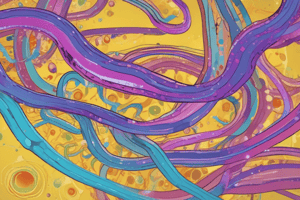Podcast
Questions and Answers
What is the primary morphological characteristic of Vibrio species?
What is the primary morphological characteristic of Vibrio species?
- Curved, comma-shaped rods (correct)
- Straight, rod-shaped bacilli
- Spherical-shaped cocci
- Spiral-shaped spirochetes
Which of the following is NOT a virulence factor of Vibrio cholerae?
Which of the following is NOT a virulence factor of Vibrio cholerae?
- Flagellum
- Endotoxin (correct)
- Pili/adhesin factors
- Cholera Toxin
Which of these describes the typical stool presentation in a severe case of Vibrio cholerae infection?
Which of these describes the typical stool presentation in a severe case of Vibrio cholerae infection?
- Formed and solid
- Dark, tarry appearance
- Watery, “rice-water” stools (correct)
- Bloody and mucous-filled
What is the primary mechanism of action of cholera enterotoxin produced by Vibrio cholerae?
What is the primary mechanism of action of cholera enterotoxin produced by Vibrio cholerae?
What is the most critical therapeutic intervention for a patient with a Vibrio cholerae infection?
What is the most critical therapeutic intervention for a patient with a Vibrio cholerae infection?
Which of the following growth characteristics is most accurate for Helicobacter pylori?
Which of the following growth characteristics is most accurate for Helicobacter pylori?
What specific enzyme produced by Helicobacter pylori allows it to endure the harsh acidic environment of the stomach?
What specific enzyme produced by Helicobacter pylori allows it to endure the harsh acidic environment of the stomach?
What distinctive motility characteristic is associated with Helicobacter pylori?
What distinctive motility characteristic is associated with Helicobacter pylori?
Flashcards
Vibrio
Vibrio
A type of bacteria that is curved, gram-negative, and motile due to a single polar flagella. They are often found in saltwater environments and can cause various infections, including cholera.
V. cholerae
V. cholerae
A specific type of Vibrio bacteria that is responsible for causing cholera outbreaks. It produces a toxin that leads to severe diarrhea and dehydration.
Cholera toxin
Cholera toxin
A substance produced by V. cholerae that causes the characteristic watery diarrhea of cholera. It disrupts the function of intestinal cells, leading to fluid loss.
Colonization
Colonization
Signup and view all the flashcards
Helicobacter pylori
Helicobacter pylori
Signup and view all the flashcards
Urease
Urease
Signup and view all the flashcards
Infection
Infection
Signup and view all the flashcards
Motility
Motility
Signup and view all the flashcards
Study Notes
Vibrio Cholera
- Vibrio species are motile, curved, Gram-negative bacilli (comma-shaped rods).
- Vibrio species are facultative anaerobic organisms.
- Their natural habitat is saltwater, where they multiply in shellfish and plankton.
- Major human pathogens include V. cholerae, V. parahaemolyticus, and V. vulnificus.
- V. cholera 01 and 0139 produce cholera enterotoxin, linked to cholera epidemics.
- V. cholera virulence factors include pili/adhesins, flagellum, hemagglutinin-protease, neuraminidase, siderophores, and cholera toxin.
- Cholera toxin induces massive diarrhea by increasing adenyl cyclase activity in mucosal cells.
- Severe V. cholera infection can result in severe fluid loss and electrolyte imbalances, leading to dehydration, muscle cramps, metabolic acidosis, and potentially hypovolemic shock and renal failure.
- Mortality rates are high in untreated cases, but are low in cases with fluid and electrolyte replacement therapies.
- Diagnosis involves microscopic examination (Gram stain) of stool samples and culturing the bacteria using TCBS agar (thiosulfate-citrate-bile salts-sucrose agar).
- Treatment involves fluid and electrolyte replacement, with antibiotic options such as azithromycin or doxycycline or ciprofloxacin.
Helicobacter Pylori
- H. pylori is a curved, Gram-negative bacillus requiring microaerophilic environments.
- H. pylori are highly motile (corkscrew motility) due to 5-6 polar flagella.
- H. pylori produce urease, which allows them to survive in harsh gastric environments.
- Humans are the primary reservoir for H. pylori.
- H. pylori infection can be transmitted from person to person, and through fecal-oral and oral-oral routes.
- Infections are ubiquitous and commonly cluster in families..
- H. pylori is linked to several gastrointestinal diseases, including:
- Type B gastritis
- Gastric ulcers
- Gastric cancers (gastric adenocarcinoma of the body and antrum and gastric mucosa-associated lymphoid tissue [MALT] B-cell lymphomas)
- H. pylori virulence factors include:
- Lytic enzymes (mucinases)
- CagA protein
- VacA protein
- Attachment factors
- Flagella
- H. pylori can cause inflammation and damage to the stomach lining, leading to gastritis and ulcers.
- H. pylori infections often cause alteration of signaling pathways, cytoskeletal rearrangement, and disruption of tight junctions.
- Diagnosis methods include urea breath tests (non-invasive), gastric biopsy (invasive), and detection of H. pylori antigens in stool samples or IgG in serum samples.
- Treatment often involves triple therapy, consisting of a proton pump inhibitor, a macrolide, and a beta-lactam antibiotic, for 7-10 days.
Studying That Suits You
Use AI to generate personalized quizzes and flashcards to suit your learning preferences.




